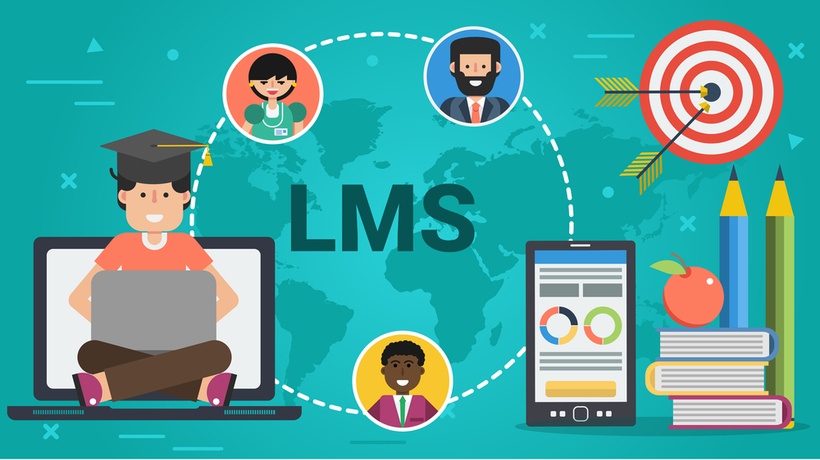Important LMS Selection Traps
Choosing a new LMS can be a very daunting and complex task, even if you’ve done it before. In fact, your deep expertise in LMS technology might actually lead you astray, shifting your focus to the wrong criteria and keeping you from selecting the best LMS for your organization. Today’s learners are different. They’ve become far more sophisticated in their use of technology, and their expectations for usability have skyrocketed. As a result, your focus on avoiding common LMS selection traps should be even greater. Expertus created the free eBook LMS Buyer’s Kit to inform potential LMS buyers as to what elements to avoid.
With a new generation of learners and vastly different technology possibilities, you now need different criteria to select the most suitable LMS. Using the same criteria you used five years ago simply won’t do. Read on and learn which are the four most common LMS selection traps today’s organizations fall into and how you can avoid them.
1. Focusing On Quantity Of Features Instead Of Usability
Looking for too many LMS features is one of the common LMS selection traps you should be aware of. Enterprise software, including Learning Management Systems, is famously difficult to learn and use. For much of the last decade, usability was an afterthought compared to sheer quantity of features.
This is because early LMSs built in the ‘90s, were designed only for administrators to use. Subsequent product generations, built five to ten years ago, evolved and gradually allowed learners more and more access to functionality. However, learner functionality was built on top of the complex administration functionality. It was more of an afterthought than a true focus.
Results were what you’d expect. Systems with complex features that were mostly useful to administrators rather than learners. However, the price for those products was huge. There was great lack of usability, and workflows were non-intuitive and cumbersome. Functionality was inconsistently or incompletely implemented across the product. All users, including admins, managers and learners, needed to take training classes to learn how to use the LMS. In other words, they had to get training on a system that was supposed to train them!
However, in the early to mid-2000s, businesses shrugged and accepted this poor state of affairs. At the time, most LMS selection processes focused on the quantity of features for administrators. Some old guard vendors strongly encouraged these “feature wars” by providing potential buyers with free LMS RFP templates. These RFP templates were huge checklists, listing each and every minor feature a model LMS should have, even if many of these features provided scant benefit.
Very few, if any, LMSs on the market then emphasized usability for learners. On the contrary, LMS vendors just added more and more features, to give them an advantage in feature-driven selection processes. However, having too many features actually degrades usability. Learners didn’t have particularly high expectations for usability. They simply didn’t know what was possible.
Things are different now, though. Since those days, learners have experienced several intuitive, easy-to-use applications in their personal lives that require no training and get great results. These learners now expect their LMS to have as good, or even better, of a user experience than their consumer applications. And if their expectations aren’t met, they simply won’t use the LMS. If needed, they’ll go outside their organization for more expensive training that’s not necessarily aligned with their company’s mission.
But even though today’s learners are very different and demand extreme usability above all else, some LMS buyers don’t recognize the paradigm shift. They still use the same feature-driven LMS selection process that was in vogue five to ten years ago, and focus on the needs of the admin over the learner. This is deadly, and one of the LMS selection traps you must avoid if you want your users to willingly use your LMS.
Be sure to focus your selection on usability for the learner. Concentrate on the subset of LMS functionality that’s truly essential for your business. Keep in mind that all extra functionality will just make your LMS more difficult to learn and use.
2. Incorrectly Evaluating The Usability Of An LMS
Let’s assume that you’ve side-stepped the first of four LMS selection traps, and you've decided to thoroughly evaluate each LMS’ usability. The problem is, every LMS vendor claims their product is the most usable. So, how do you actually do it? How do you evaluate usability for learners before you’ve actually used the LMS day-in and day-out for many weeks? The free eBook LMS Buyer's Kit provides well-substantiated answers to all of these questions.
Watch out because here lies the second of four deadly LMS selection traps, namely to incorrectly evaluate the true usability of an LMS. Unfortunately, it’s too common for organizations to see a product demo and give it high marks in usability, only to find out weeks or months later that the product is actually so cumbersome that learners won’t willingly use it.
Here’s some advice to evaluate a product’s true usability and avoid being dazzled by a demo.
To begin with, understand that true, deep usability is more of an editing function than an adding function. To make it obvious what the user should do next, the LMS should intelligently use what it knows about the specific user to remove wasted steps, hide extraneous information and reduce the number of choices available to the user on the screen. This is called “profile-based” or “group-based” user interface design. The goal is to focus the user’s attention on what they need to do at the appropriate time.
For example, if an employee must take four courses to be compliant, then when the user is selecting classes to take, the user interface should only display those four courses. It would be even better if it displayed only the classes of the four which the user hasn’t already taken. The user interface then automatically adapts to a management user who has 20 classes available to him.
What’s more, you should also focus on the workflows that learners will use almost every time they use your LMS. Look at usability for the most commonly performed tasks over the long haul, not just the first few months. You want those tasks to be as intuitive and streamlined as possible.
User training can’t overcome usability deficiencies in your LMS. Training might work for some products, but it doesn’t work here because learners don't use Learning Management Systems every day. Oftentimes a learner will use the LMS intensely for a few days as they search for training, register, take a few courses and update their training record. Then they won’t use the LMS for another few months. Since they use the LMS so sporadically, learners can easily forget how to use it in-between uses. Offering LMS training to learners doesn’t help because it, too, is quickly forgotten when they only use the system every few months.
Instead, you need an LMS where the user interface makes it obvious what each learner needs to do and how to do it. You can only get to the desired result by streamlining the most common workflows and by displaying only essential, contextualized information.
Realize that an attractive visual design doesn’t, on its own, improve usability. Many old guard LMS vendors have recently given their decade-old products a cosmetic makeover. They have switched to thin San Serif fonts, using brightly colored square buttons and avoiding color gradients, shadows and 3D effects. While these changes make their products more pleasing to the eye, on their own they don’t improve usability. You cannot achieve true usability without streamlining the most common workflows and without removing inapplicable choices and steps based on the user’s profile and context.
In addition, don’t neglect usability for administrators. While the emphasis should be on learner usability, usability for administrators is also very important. Again, the LMS should streamline tasks that admins do on a regular basis, giving them fewer clicks, drag and drop functionality, automated assignment and so on. Typical workflows should use sensible defaults, but provide your administrators with ways to override and access more powerful settings.
3. Undervaluing The Importance Of A Modern Technical Architecture
Five years ago, a feature-laden, cloud-based UI was considered state-of-the-art for an enterprise LMS. However, this doesn’t hold true anymore and is one of the most ordinary LMS selection traps. To support learners in the post-iPhone, post-Facebook era, today’s LMS needs to support entirely new modes of interaction with learners, in order to meet their high expectations. These new expected LMS capabilities are numerous and the LMS Buyer's Kit provides insight into all of them.
First and foremost, learner usability is an important capability. Second, mobile access and support that goes beyond modifying the LMS’ web UI to display nicely on an iPhone web browser is key. True mobility takes advantage of the unique capabilities of mobile devices to do what the traditional web-based user interface couldn’t. It helps solve some of the biggest challenges learners and instructors face. Third, social collaboration is indispensable and enables today’s learners to build a community and share what they’ve learned with others. These capabilities include a lot of social functionality inspired by Facebook, LinkedIn and forums. The goal is to enhance the interactions that learners have with each other, instructors, SMEs and more, both in person and online.
Lastly, gamification is another LMS capability that engages learners and motivates them to achieve new levels of mastery. Virtual person-to-person interaction via online meetings is something learners expect to see in an LMS. What’s more, advanced analytics and reporting functionality that improves the efficiency and effectiveness of your learning organization is now a must have.
In addition to providing these next-gen capabilities, an LMS with a modern architecture must be designed to easily communicate with a host of other systems, be they in the cloud or on-premise. This includes both inbound and outbound communication, and includes systems that we don’t even know about yet.
Fortunately, most modern applications use the same mechanisms to integrate, namely REST APIs. REST APIs provide a standards-based method for any application to communicate with any other system in a lightweight and robust fashion using standard Internet communication protocols. It’s the overwhelmingly dominant way for remote systems to connect. As a result, it’s very important to select an LMS that supports it.
In short, don’t fall into the trap of assuming that all LMSs have robust underlying technology that will be able to take you five to ten years into the future. To be able to handle today’s users, your LMS needs social, mobile, gamification, analytics and usability built into its core. These are next-gen capabilities, so look for a newer LMS that was built from the ground-up within the last five years.
4. Believing That Mobility Is Only About Replicating Functionality On Mobile Devices
Today, mobile and computing-anywhere devices like mobile phones and tablets are pervasive. Many companies have stopped issuing laptops to employees, and instead, lower costs, and convenience, by giving them tablets or smartphones. Users and admins must be able to access your LMS from the mobile devices of their choice. However, just reworking the user interface to display nicely in mobile devices is not enough. As a result, commonplace LMS selection traps include replicating funtionality as well.
Ask yourself the following critical questions when evaluating an LMS’ mobile capabilities:
- Does the LMS provide a full-featured iPhone app, as well as an Android app?
- Are there also native apps for tablets?
- Does the Android app support all devices?
- Are the website and any web-based user interfaces tailored to the needs of your mobile users?
- Is the UI able to automatically re-organize depending on the size of the display?
Also, when evaluating an LMS’ mobile capabilities, think of what mobile devices can accomplish via geolocation that desktop-only LMSs can’t. True LMS mobility takes advantage of the unique capabilities of mobile devices to do what the traditional web-based user interface cannot. This solves some of the biggest challenges learners, managers and instructors face.
You might have previous experience with Learning Management Systems. However, it is not difficult to fall into one of those LMS selection traps. As discussed above, there is an array of elements you should pay attention to, and try to avoid, if you want to pick the right LMS.
Download the free eBook LMS Buyer's Kit and get informed on important questions to best analyze your company’s LMS selection needs. The LMS Buyer’s Kit will additionally educate you on criteria that will help you select a quality LMS software provider.









